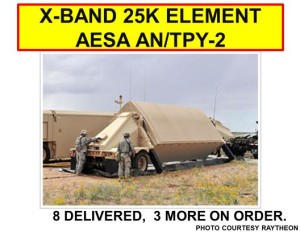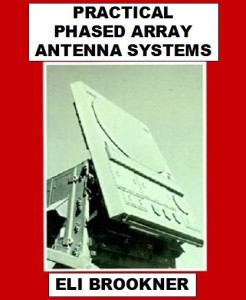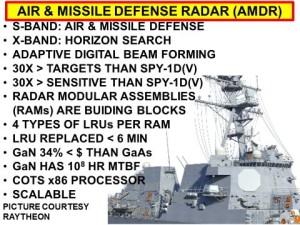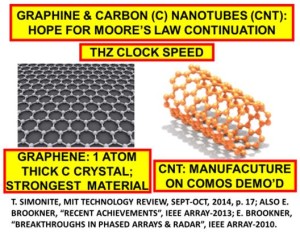Phased Array and Adaptive-Array Fundamentals and their Recent Advances – Spring 2016
202 Burlington Rd
Bedford, MA 01730
USA
Mondays, March 14, 21, 28, April 4, 25, May 9, 16, 23, June 6, 13
Decision (Run/Cancel) Date for this Course is March 7, 2016
Payment received by 3 March
IEEE Members $300
Non-members $340
Payment received after 3 March
IEEE Members $340
Non-members $370
Phone 781-245-5405
email sec.boston@ieee.org
Fax 781-245-5406
Make Checks payable to:
IEEE Boston Section
One Centre Street, Suite 203
Wakefield, MA 01880
Speaker: Dr. Eli Brookner, Raytheon Company (Retired)
Text: “Practical Phased Array Antenna Systems”, Dr. Eli Brookner, Editor, Artech House, 1991
Your registration includes:
1 textbook
15 reprints
Over 800 vugraphs
“Practical Phased Array Antenna Systems”, Dr. Eli Brookner, Editor, Artech House, 1991, Hardcover, 258 pages, List Price $179, Hardcover, 258 pages. Covers array fundamentals: phase and time-delay steering; grating lobes for 1- and 2-dimensional arrays; effects of errors and failures on gain, sidelobes and angle accuracy; array weighting, thinning, blindness, mutual coupling, elements, phase-shifters and feeds; limited field of view (LFOV) arrays; SPY-1; example design.
This course is based on the book entitled Practical Phased Array Antenna Systems by Dr. Eli Brookner. The book covers array basics and fundamentals which do not change with time. The course, the book and the notes will provide an ideal introduction to the principles of phased array antenna design and adaptive arrays. The course material and notes cover in addition recent developments in phased arrays updated to 2016.
With the explicitly tutorial approach the course and book offers a concise, introductory-level survey of the fundamentals without dwelling on extensive mathematical derivations or abstruse theory. Instead a physical feel will be given. The book provides extensive curves, tables and illustrative examples.
Covered in easy terms will be sidelobe cancellation, full adaptive array processing without suffering its computation complexity (through the use of adaptive-adaptive array processing also called beam-space processing and eigenbeam processing). Finally, Space-Time Adaptive Array (STAP) for airborne platforms will be explained and related to the displaced phase center antenna (DPCA).
This course is intended for the engineer or scientist not familiar with phased-array antennas as well as the antenna specialist who wants to learn about other aspects of phased-array antenna systems. The major emphasis will be on the system aspects of phased-array systems.
Lecture #1. Monday March 14; Phased Array Fundamentals: Fundamental Principles of Electronically Scanned Array (ESA) explained with tube COBRA DANE used as example. Covered will be: Near and Far Field Definitions, Phased Steering, Switched-Line Phase Steering; Time Delay Steering, Subarraying, Array Weighting, Monopulse, Duplexing, Array Thinning, Embedded Element, dual polarized circular waveguide element, advantage of triangular lattice over square lattice, Tour of COBRA DANE (6 stories high) via color slides.
Lecture #2. Monday March 21; Linear Array Fundamentals: Conditions for no grating lobes; beamwidth vs scan angle; sine space; Array Factor; sidelobe level vs antenna beamwidth; directivity; antenna efficiency factors; array weightings; array frequency scanning; array bandwith.
Lecture #3. Monday March 28; Planar Arrays: Array Factor; array separability; sine-space (sinα-sinß space, T- space); grating lobes location for triangular and rectangular lattice; directivity; very useful bell curve approximation; array thinning system issues.
Lecture #4. Monday April 4; Array Errors: Effects of element phase and amplitude element errors and element failures; simple physical derivation of error effects; paired echo theory; subarray errors; quantization errors; examples.
Lecture #5. Monday April 25; Radiating Elements: Waveguide; dipole; slotted waveguide; microstrip patch; stacked patch; notch (wideband); spiral; matching (wide-angle); waveguide simulator; practical limitations, mutual coupling and array blindness; scattering matrix; design procedure; , polarization miss-match loss.
Lecture #6. Monday May 9; Active Phased Arrays: 2nd generation solid state hybrid active electronically scanned array (AESAs) covered using PAVE PAWS as example, T/R Module Introduced, Cross Bent Dipole Element, Mutual Coupling, Array Blindness, Tour of PAVE PAWS (6 stories) via color slides. 3rd Generation AESAs: THAAD, SPY-3, IRIDIUM, F-15 APQ-63(V)2, APG-79, XBR, AMDR and upgraded Patriot GaAs and GaN microwave integrated circuits (Monolithic Microwave Integrated Circuit, MMIC).
Lecture #7. Monday May 16; Array Feeds: Corporate and space fed; Reactive (lossless) and matched (Wilkinson); even/odd node analysis. Serial; Ladder; Lopez; Blass; Radial, Butler matrix; microstrip/stripline; Rotman Lens; SLQ-32; PATRIOT space-fed array; reflectarray. System Considerations: sequential detection, beam shape loss; receiver and A/D dynamic range; polarization miss-match loss; array noise figure and system temperature taking into account array mismatch. Phase Shifters: Diode switched-line, hybrid-coupled, loaded-line; ferrite phase-shifters: non-reciprocal latching; diode vs ferrite; MEMS (Micro-Electro-Mechanical Systems) and its potential for a low cost ESA.
Lecture #8. Monday May 23; Limited Scan (Limited Field of View [LFOV]) Arrays: Explained using simple high school optics for TPS-25, 1st Electronically Scanned Array (ESA) put in production. Fundamental Theorem specifying minimum number of phase shifters needed for a specified scan angle. Method for realizing this minimum using overlapped array antenna elements as with HIPSAF lens array system and Microwave Landing System (MLS); reflector; randomized oversized elements; use of sum and difference patterns; use of spatial filters to reduce grating lobes and sidelobes. Hemispherical Coverage Dome Antenna.
Lecture #9. Monday June 6; Phased Array Amazing Advances and Breakthroughs — Part 1: Systems: Patriot now has GaN active electronically scanned array (AESA) providing 360o coverage, now a 2015 state-of-the-art AESA radar system; S/X-band AMDR provides 30 times the sensitivity and number of tracks as SPY-1D(V); JLENS aerostat radar system now deployed over Washington DC; 3, 4, 6 faced “Aegis” radar systems developed by China, Japan, Australia, Netherlands, USA; Low Cost, Low Power Extreme MMIC (Moore’s law at Microwave and mm-waves): 4 T/R modules on single chip at X-band costing ~$10 per T/R module ; Intel single chip 32-Element 60 GHz Tx/Rx Phased Array, full phased array on wafer at 110 GHz; on-chip built-in-self-test (BIST), will be used in the internet-of-things and in cell phones which by 2020 is expected to number 50 billion, expect such single chip arrays to cost only few dollars in future; All the RF circuitry for mm-wave automobile radars at 25 GHz and 77 GHz are being put on a chip with some believing that such arrays and radars will soon be produced for just a few dollars; Valeo Raytheon (now Valeo Radar) developed low cost, $100s, car 25 GHz 7 beam phased array radar; about 2 million sold already, more than all the radars ever built up to a very few years ago. Digital Beam Forming (DBF): Israel, Thales and Australia AESAs have under development array with an A/D for every element channel; Raytheon developing mixer-less direct RF A/D having >400 MHz instantaneous bandwidth, reconfigurable between S and X-band; Radio Astronomers looking at using arrays with DBF. Materials: GaN can now put 5X to 10X the power of GaAs in same footprint, 38% less costly, 100 million hr MTBF, Raytheon invested $150 million to develop GaN; SiGe for backend, GaN for front end of T/R module. MIMO (Multiple Input Multiple Output): Where it makes sense; contrary to what is claimed MIMO array radars do not provide 1, 2 or 3 orders of magnitude better resolution and accuracy than conventional array radars; MIMO does not provide better barrage-noise-jammer, repeater-jammer or hot-clutter rejection than conventional array radars; contrary to claims MIMO should not provide better minimum detectable velocity for airborne radars.
Sidelobe Cancellers (SLC): The simple single-loop, feed-forward canceller is introduced in easy terms. This is followed by a discussion of the simple single-loop feedback canceller with and without hard limiting. The normalized feedback SLC will also be covered. Presented will be their performance; transient response and cancellation ratio. Next the multiple-loop SLC (MSLC) will be covered. Applied to the MSLC will be the Gram-Schmidt, Givens and Householder orthonormal transformation methods. Systolic array implementations will be given.
Lecture
#10. Monday June 13; Fully Adaptive Arrays: The optimum weight for a fully adaptive array is developed using a very simple derivation. Methods for calculating this optimum weight are given using the Sample Matrix Inversion (SMI) algorithm, the Applebaum-Howells adaptive feedback loop method, a recursive method, and Gram-Schmidt, Givens and Householder orthonormal transformations developed for the tracking problem and for the MSLC. The use of eigenvector beams and a whitening filter will also be developed. It will be shown how the latter reduces the transient response. Methods for obtaining the benefits of a fully adaptive array without its high computation and large transient time disadvantages are given. These are the adaptive-adaptive array processing procedures, the use of eigenbeam space, and the method of finding the largest eigenvalues and in turn their eigenbeams. The STAP algorithm will be introduced.
Phased Array Amazing Advances and Breakthroughs — Part 2: Metamaterials: Material custom made (not found in nature): using 20 and 30 GHz metamaterial electronically steered antennas about the size of a laptop developed for transmission to satellites and back was demonstrated December 2013, goal is $1K per antenna, remains to prove low cost and reliability, how this antenna works explained for first time; 2-20GHz stealthing by absorption simulated using <1 mm coating; target made invisible over 50% bandwidth at L-band; Focus 6X beyond diffraction limit at 0.38 μm; 40X diffraction limit, λ/80, at 375 MHz; In cell phones provides antennas 5X smaller (1/10th λ) having 700 MHz-2.7 GHz bandwidth; The Army Research Laboratory in Adelphi MD has funded the development of a low profile metamaterial 250-505 MHZ antenna having a /20 thickness; Provides isolation between antennas with 2.5 cm separation equivalent to 1 m separation; used for phased array WAIM; n-doped graphene has negative index of refraction, first such material found in nature; Digital Processing and Moore’s Law: Not dead yet; Slowed down but has much more to go; Expect increase in transistors density by about a factor of ~50 in the next 30 years and reduction in signal processing power consumption by factor of ~75; and then there is graphene which has potential for terahertz transistor clock speeds, manufacture on CMOS demonstrated, could allow Moore’s law to march forward using present day manufacturing techniques; there is also spintronics which could revolutionize the computer architecture away from the John von Neumann model; and there is finally doing computation the way the brain efficiently and amazingly does perhaps by using synaptic transistors and/or memristors, remember the brain only weighs about 2-3 pounds and uses only ~20 W, we have a long way to go; Low Cost Packaging: Raytheon funding development of low cost flat panel X-band AESA using COTS type printed circuit boards (PCBs); Rockwell Collins doing it for airborne AESA; Lincoln-Lab./MA-COM developing low cost S-band flat panel array using PCBs, overlapped subarrays and a T/R switch instead of a circulator; SAR/ISAR: Principal Components of matrix formed from prominent scatterers track history used to determine target unknown motion and thus compensate for it to provide focused ISAR image. Technology and Algorithms: A dual polarized, low profile, (/40), wideband (1:20) antenna can be built using tightly coupled dipole antennas (TCDA); Lincoln Lab increases spurious free dynamic range of receiver plus A/D by 40 dB; MEMS: reliability reaches 300 billion cycles without failure; Has potential to reduce the T/R module count in an array by a factor of 2 to 4; Can provide microwave filters 200 MHz wide tunable from 8-12 GHz; MEMS Piezoelectric Material = piezoMEMS: Enables flying insect robots; Printed Electronics: Low cost 1.6 GHz (goal 2.4 GHz) diodes printed with Si and NbSi2 particles; Electrical and Optical Signals on Same Chip: IR beams could be used for transporting on computer chips digital information at the speed of light; COSMOS: DARPA revolutionary MMIC program: Allows integration of III-V, CMOS and opto-electronics on one chip without bonded wires leading to higher performance, lower power, smaller size, components; Graphene and Carbon Nanotube (CNT): potential also for non-volatile memory, flexible displays and camouflage clothing, self-cooling, IBM producing 200 mm wafers with RF devices; Superconductivity: We may still achieve superconductivity at room temperature; Superconductivity recently obtained for first time with iron compounds; Biodegradable Array of Transistors or LEDs: Imbedded for detecting cancer or low glucose; can then dispense chemotherapy or insulin; Quantum Radar: See stealth targets; New polarizations: OAMs, (Orbital Angular Momentum) unlimited data rate over finite band using new polarizations?? Bio: Biodegradable array of transistors or LEDs for detecting cancer or low glucose, can then dispense chemotherapy or insulin; Can now grow functioning non-rejecting kidney and heart for rats.






